|
Summer/Fall 2005

Canadian Pacific Railway Employee Communications
Room 500 401-9th Ave
S.W. Calgary AB T2P 4Z4
Expanding Our Horizons
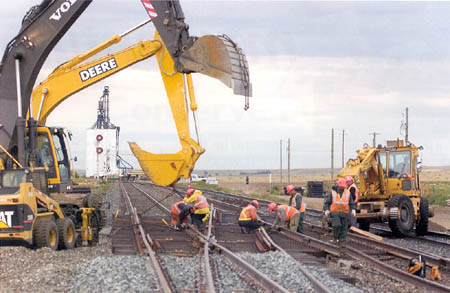
An intricate pattern of crossovers is installed at Dunmore,
Alberta.
The Ambitious WestCap Project helps
the
railway boost capacity and stay fluid
The day starts early for crews working on WestCap, CPR's ambitious 2005 Western Capacity Expansion Project. The work
season runs from mid-spring to mid-fall, weather permitting, a daunting timeframe to
install 530,000 feet of new, heavy, premium rail, 137,000 crossties, and 300,000 tons of rock ballast at more than
20 separate locations. At 5 a.m. on a foggy morning in September, Momentum Caught up with crews working at
Dunmore, Alberta, one of the largest WestCap projects. They had already been at work for a couple of hours.
| |
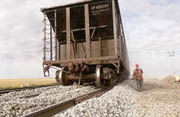
It's all ballasted by day's end.
|
Traffic on western lines is up by as much as 50 percent on some Western corridors and Dunmore is one of the
congestion points caused by a limited capacity for trains to meet and pass. The work at Dunmore includes the full
gamut of WestCap tactics for restoring rail traffic capacity that is typical of the project as a whole:
extending sidings, laying sections of double track, improving signal systems, and installing staging tracks and
track-to-track crossovers.
That morning assistant track maintenance supervisor Darrell Supovorich and his track crew were working full out to
install a number of track panels, while a large, well-equipped tie crew moved toward them at a brisk
pace. "I don't mind working this early", said assistant track program supervisor Don Orschy, as the sun was
rising. "It's nice and peaceful at night". Don's with the tie crew that has come from Saskatchewan to work
on the WestCap project at Dunmore. "We'll change out about 120,000 ties this season between Medicine Hat and
Swift Current, and over in Alberta", he said.
| |
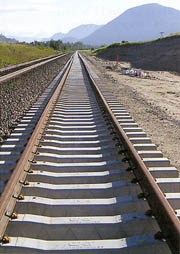
Concrete ties at Pritchard, B.C.
Seamless Super Rail
On WestCap projects,
CPR is installing premium chrome-alloy rail to support the long, heavy trains that increase
productivity in rail operations. On mountain grades, the newest generation of premium rail, highly resistant to
wear and fatigue, will carry heavy loads on heavy curves, under the most demanding operating conditions. The
new rail has high chromium content and the steel in the railhead is hardened to a greater degree and depth than
in standard rail. Its longer service life reduces maintenance and replacement costs.
CPR is installing both hardwood and concrete ties during the capacity expansion project. About 25 percent of
the 137,000 ties are concrete ties cast with steel plates imbedded where the rail sits to reduce abrasion and
extend the service life of the ties. The concrete ties should last up to 40 years, compared with a hardwood
lifespan of 20 to 25 years.
|
Track program supervisor Brent Churylo adds that most of his guys would already be laid off for the season, if not
for the extra work arranged by the CPR and the TCRC. "Thirty-five guys with the
"Saskatchewan High-Density Crew" were asked to come here to help out the "Alberta Super
Tie Crew", he says. "We work long hours, but we get three-day weekends at home. And it's a few
extra bucks".
By the end of the crew shift at 11 a.m., a few hundred feet of new track has been spiked down and ballasted, and is
ready to go. When all the WestCap projects are completed, we will be able to run an additional four trains daily
between the Prairies and the Port of Vancouver, a 12 percent increase in capacity.
As well, we are taking other steps to support the booming North American economy, among them adding more modern
locomotives and rail cars to our equipment fleets, undertaking an aggressive track maintenance program across our
system, and hiring hundreds of new train crew employees. During the work season in 2005 alone, as many as 362 new
TP&E and S&C employees were hired to handle the extra volume of work for WestCap and our regular track
programs.
"It's been a big year", said Vern Graham, vice-president of engineering services. "We've
had to come up with the best possible work schedule to fit our Integrated Operating Plan, allowing us to put through
as many trains as possible, while we maximize our track programs to get as much fluidity from our network as we can.
It's all been well choreographed by our Capacity Management Work Block Planning Team from service design,
transportation/field ops, engineering and supply services".
CPR has been expanding its capacity to move more bulk commodities and resources to the Port of Vancouver to meet the
demand of Asian markets. We're also moving increased volumes of finished goods, shipped in containers arriving from
Asia, to consumers in the U.S. and Canada. "There are great growth opportunities in the next three to five years
for the Canadian economy and for the railway's traffic outlook", said Don Campbell, CPR's
vice-president of business planning & development. As a result, we're getting tremendous support for
building capacity from shippers, from the federal government, and from the provincial governments".
The various WestCap projects have also involved intensive negotiations with local town, city, and country councils
about potential public concerns. Where possible, level crossings are being eliminated, or redesigned to be safer; and
new access roads are being built to government standards at CPR expense. "In many cases we've met directly with
residents to ensure that we are doing everything possible to be approachable and environmentally friendly, and to be
good neighbours in the communities where we operate", said community relations manager Rick Poznikoff. "We
are also greatly appreciative of the cooperation and assistance we have received from regulatory and government
agencies that has allowed WestCap to proceed without delays".
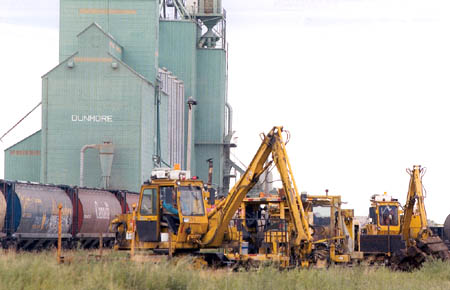
The "Saskatchewan High-Density Crew"
crossed the border to help out at Dunmore, while the "Alberta Super Tie Crew" work at another
site.
Capacity Team Choreographs
Work
WestCap Flagmen: From left, track maintenance
foremen Bobby Michell and Tony Sam watch over the work at Monro, while Doug Haugen protects the crews at Savona,
on just two of the capacity expansion projects on the CPR main line in British
Columbia.
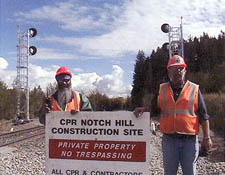 |
|
One Less Bottleneck
in the
System
Senior flagman Jagjit Parmaand and construction
manager Neil Faulkner at the WestCap site at Notch Hill. Additional double tracking will provide a minimum of
10,000 feet of capacity between crossovers, to provide a passing capability at Notch Hill and add capacity on
a critical corridor. The new signal masts for the extended double track are visible in the
background.
|
This Momentum magazine article is copyright
2005 by Canadian Pacific Railway and is reprinted here with their permission. All photographs, logos, and trademarks
are the property of the Canadian Pacific Railway Company.
|